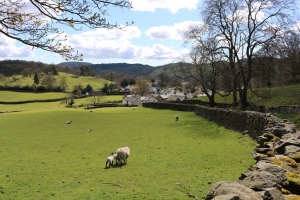
Hill Top – Beatrix’s farm in Near Sawrey, in the Lake District – it features in The Tale of Tom Kitten and The Tale of Samuel Whiskers
Just six years ago the New York Times was lamenting the decline in popularity of children’s picture books, apparently due in part to ambitious parents pushing their offspring to move onto more preferable, text-heavy, chapter books!
But on the 150th anniversary of Beatrix Potter’s birth, global enthusiasm for her little picture books remains as strong as ever, and the interest surrounding the September release of a rediscovered Potter manuscript confirms we can’t get enough of them.
She remains one of the most beloved children’s authors of all time, with her Tales translated into 35 languages and selling more than 100 million copies since The Tale of Peter Rabbit was published in 1902. With new generations continually discovering the joy of her books, over two million copies continue to sell each year.
Naturalist and illustrator
Potter was a keen naturalist from childhood and spent much of her time observing and sketching animals, birds and insects – both the pets she and her brother kept (rabbits, mice, guinea-pigs, bats!) in the family’s London home, as well as the stuffed specimens and skeletons on display in museums nearby.
Her creativity was stirred by family holidays to Scotland and the Lake District – the latter kindling a lifelong passion in her – and she soon began to incorporate countryside images into her artwork, becoming as skillful with bucolic scenes as with the animal form.
She wrote in her journal, ‘It is all the same, drawing, painting, modelling, the irresistible desire to copy any beautiful object which strikes the eye. Why cannot one be content to look at it? I cannot rest, I must draw.’ And she did, producing thousands of beautifully delicate and scientifically accurate sketches, line drawings and watercolours.
In 1890, with a desire for more financial independence and the encouragement of her brother Bertram, she turned some of her imaginative animal drawings into Christmas card designs and sold them to a greeting cards company for £6. Her career as an illustrator had begun.
The bunny book

The village of Near Sawrey – many of its scenes can be recognised in The Tale of Ginger and Pickles
Three years on, while holidaying in Scotland, she wrote a ‘picture letter’ (as she described it) to the sickly son of a former governess and friend. She included a few quick line drawings of rabbits, along with a little tale about them. The letter began: ‘My dear Noel, I don’t know what to write to you, so I shall tell you a story about four little rabbits whose names were Flopsy, Mopsy, Cottontail and Peter.’
But it wasn’t until several years later that she decided to turn the rabbit story into a manuscript. She borrowed back Noel’s letter, copied it out, and added in more adventures to lengthen it.
But it was rejected by six different publishers. Determined to see it in print, she resolved in 1901 to self-publish 250 copies of it for a Christmas gift. It was so well received she had a further 200 printed.
Warne & Co then reconsidered her submission – with the proviso that she change her black and white pen-and-ink drawings to full-colour illustrations – and The Tale of Peter Rabbit was born. In just over a year it sold 50 000 copies. She went on to produce another 22 Tales, as well as 11 other books.
Beatrix was meticulous about depicting the world around her as true to life as possible. The scientific detail of her animal characters and the delicate nature of her impressions of the English countryside was extraordinary.
But perhaps it was her lively imagination and sense of humour – evident in the way her country creatures were set within scenes of everyday human domestic routine – along with the preciseness of the text, that has given the books their timeless appeal.
The Tale of Kitty-in-Boots
It’s fitting then that just over 150 years since her birth a previously-unseen Beatrix Potter manuscript will be released by her original publishers Frederick Warne & Co and illustrated by Quentin Blake, probably best-known for his Roald Dahl sketches.
Beatrix wrote The Tale of Kitty-in-Boots in 1914 and completed one rough colour sketch for it, at the time describing the tale to her publishers as featuring ‘a well-behaved prime black Kitty cat, who leads rather a double life’.
But the story of the mischievous kitten was interrupted and she never finished it. A publisher at Penguin Random House Children’s discovered several references to Kitty in a biography from the 1970s, and went on to locate the unedited manuscript in the Victoria and Albert Museum archives. The new book will be released on 1 September, to the delight of Potter fanatics worldwide.
This year’s 150th anniversary celebrations have seen Beatrix Potter enthusiasts go batty once again for this much-cherished author, and the global fervour is a fitting tribute to an author and illustrator who has brought joy to so many generations of readers.
Leave A Comment